OLDSMOBILE HURST/OLDS
Autor: Marx
The 1968 was basically a Cutlass 4-4-2 Holiday coupe with several upgrades, including the 455. Force-Air Induction, performance engine tweaking, and a special Hurst Dual-Gate shifter were some of the many features on the H/O. The Hurst shifter was a tremendous innovation which enabled 3-speed Turbo Hydra-Matic operation in addition to normal manual shifting. Like the 4-4-2, the H/O featured dual stabilizer bars and four coil springs. A light car it was not, topping out at nearly 3,900 pounds, 300 more than a standard 4-4-2. Still, the '69 could run the quarter in under 14 seconds, and it had reported 0-60 times of less than 6 seconds.
While the '68 had a relatively subtle look, the '69 went all out. White bodies with Firefrost Gold striping and a huge rear spoiler made these cars stand out from the crowd. Also new this year, two functional hood scoops were placed on the hood, which were more aerodynamically sound than the previous year's intakes located under the bumper. Nevertheless, horsepower dropped to 380 -- still plenty for anyone that wanted it.
In 1968, GM had a corporate edict that forbade the installation of any engine larger than 400 cubic inches in an intermediate body. Thus, the 442 had a 400, the Chevelle a 396 and the GTO a 389. Shifter mogul George Hurst had a '68 442 that he had swapped an Olds 455 into, and found the swap to be not only successful, but relatively simple. Not only was there an increase in power, but the 455 actually weighed less then the 400 it replaced, so the 442's legendary handling remained intact. George's right-hand man, Jack "Doc" Watson, took the idea of the engine swap a few steps further, adding special paint, a Hurst shifter, engine modifications, and a walnut dash applique, and the Hurst/Olds was born.
1968
GM was not allowed to put any engine larger than a 400 cid in any A- body car, so Oldsmobile originally marketed the car as being built by Demmer Industries, but later we found out that all Demmer did was add the Hurst Dual Gate shifter and console, the walnut dash inserts, Hurst/Olds emblems and the special black markings. Oldsmobile in fact had built and installed the Monster Engines without the GM bigwigs finding out.
The first Hurst/Olds was almost a sleeper. Sedate looking in its silver and black paint scheme, it was far from sedate acting with 390 horsepower nestling under the hood. Based on the already potent 442, the H/O featured a special Toronado-only paint color, Peruvian silver, accented with black stripes and a black trunk. The 442's 400 was replaced with a hot-rodded 455 from the Toronado, which featured big-valve heads, lumpy cam, specially modified carb and distributor, and the W30's ram air induction system, with twin scoops under the front bumper. Air conditioned cars lost 10 horsepower, but still, the "gentleman's hot rod" was able to show its taillights to most competitors. A unique feature found on the '68 was the red plastic inner fender liners, which were slipped into the package by Olds boss John Beltz. On the inside, the '68 featured a walnut inlay on the dash panel and a short plastic console that housed the Hurst Dual Gate shifter. Production started on the cars late in the model year, and was handled by Demmer Engineering in Lansing, MI. Demmer had only about 30 days to convert the planned run of 500 cars. Olds had thousands of orders it couldn't fill, and the production run was finally upped to 515 to accomodate a Lansing area Olds dealer who demanded more cars. The '68 was a success by any standard, and would pave the way for a long relationship between Oldsmobile Division and Hurst Performance.
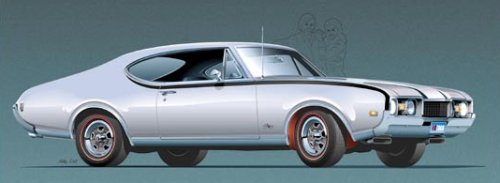
'68 H/Os should have wood on the dashes and a 'H/O by Doc Watson' sort of foil decal on the wood on the glove box. I think some of the cars might not have gotten the wood though. A real wood sport wheel and tic tac toc. It MUST have disk brakes in the front.
The Ram air scoops under the bumper should be the larger 13' scoop as opposed to the 1969 under bumper 9" scoop, and it should have a chrome molding around mouth of scoop.
The big news for enthusiasts was the introduction of the Hurst/Olds. The prototype had been designed as a one-off by Jack "Doc" Watson for his boss George Hurst, the designer of the Jaws of Life and the most respected name in transmissions. Watson took a 4-4-2 and dropped in the 455 cid V8 from the Oldsmobile Toronado. Encouraged by the success of the transplant, Jack Watson was able to convince Oldsmobile executives to authorize a limited run of Hurst/Olds. All Hurst/Olds featured Force Air systems and Turbo Hydromatics with Hurst Dual-Gate shifters and came in only one color combination, Peruvian Silver with Black accent stripes and rear-deck panel. Only 515 were produced for 1968, and they are highly prized today.
Engine: 455 V8 390bhp@5000rpm, 500lb-ft@3200rpm.
Performance: (Hurst/Olds) 455/390: 0-60 in 5.4 sec, 1/4 mile in 13.9 sec @ 103mph.
The plan was to build an executive hot rod; to clear up any misconceptions from the start, the Hurst/Olds (H/0) was built from the Cutlass, not the 4-4-2. If was the brainchild of four individuals: George Hurst and Jack "Doc" Watson from the aftermarket side, and Olds engineers John Beltz and Ted Louckes.
Power came from a modified Toronado 455 that was rated at 390 horses at 5000 rpm and 500 Ibs.-ft. of torque at 3600, thanks to a high-lift, long-duration camshaft, free-flowing cylinder heads, a recurved distributor, and a rejetted carb. Naturally, each car was fitted with the under-the-bumper Force-Air Induction system.
Being Oldsmobile hot rods, they were built with automatic transmissions and fitted with Hurst Dual Gate shifters. Rounding out the mechanical package were a heavy-duty suspension, rear end assembly with standard 3.91 gears and brakes, a higher-capacity cooling system, and G70x14-inch Goodyear Polyglas tires.
To separate the H/Os from the more plebeian Cutlasses, the new cars sported a Peruvian silver-and-black paint scheme, distinctive Hurst/Olds emblems, and a specially trimmed instrument panel.
Only 515 were ever built, although close to 2,000 were ordered. While a paper shuffle helped fool the brass, the 455s were actually installed on a factory assembly line. This fact flies in the face of legend, which has it that they were assembled at John Demmer's converted foundry on the corner of Bollard and Oakland in Lansing, Michigan. The work done at Demmer Special Machinery included paint and installation of trim, such as the wooden dash.
(According to Doc Watson, in addition to the 515 H/Os made available to the general public, there were also four built with manual transmissions╤one for him, another for John Demmer's son, and two others.)
1969 (Oldsmobile 4-4-2)
The H/O returned for '69, moving to the opposite end of the spectrum from it's silver older brother. This year, the car went wild with Cameo white paint, Hurst Fire Frost gold stripes and panels, and a monster "mailbox" hood scoop and functional rear wing. The fiberglass hood-mounted scoop provided better airflow than the under-bumper scoops used in '68. Specific 15" chrome wheels with Goodyear Polyglas GT tires put 7 inches of tire to the pavement. Motor Trend magazine dubbed the '69 "The Hairiest Oldsmobile". Mechanically, it shared the '68s drivetrain, except the 380-horse engine was the only engine available. High 13 second times in showroom trim were possible, and slicks and headers could get the car into the 12s. Just about every convenience option that was available on the 442 was available on the H/O, giving the owner a range of equipment and luxury options not generally found on musclecars of the era. Two convertibles and 912 hardtops were built. Fast and flashy, the '69 has the highest profile of all the H/Os.
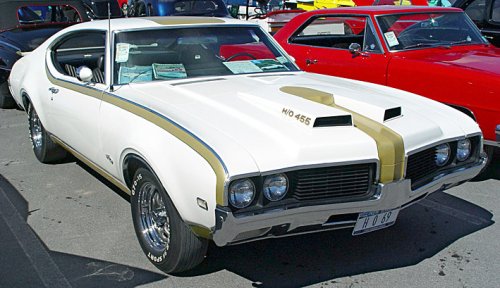
The '69 H/O was a combination of luxury options in addition to a brute force performance package. Commonly known as the "Rich Man's Hot Rod" the H/O had it all. Distinctive looks and an awesome powerplant that held its own on the street and strip. The list of options on these cars is quite extensive, starting with air conditioning and special dual racing mirrors that were imported from England. The transmissions were given special attention with a mild stall converter included. To compliment the "OH" Turbo 400 was a Hurst Dual/Gate Shifter that had the mild mannered street side and the other side for serious race shifting. The W-46 option included W-30 heads that helped make a stump pulling 500 lbs of torque and the camshaft was just right to keep those front disc brakes with enough vacuum to stop the 3700 lb beast after a run down the 1/4 mile. The hood scoops are a functional ram air system that helps feed fresh cool air into the 455 cubic inch powerplant. The spoiler was designed after a Cessna airplane parked at the Lansing Airport. It actually provides 15 lbs of downforce at 60 mph and 64 lbs at 120 mph. The wheels were SS-IIs with the chrome "built-in" the wheel (no trim ring) and were H/O only items. The 1969 Hurst/Olds started it's life as an ordinary 442 implanted with a 455 and all the extras were added. What a package Dr. Oldsmobile and Hurst put together!
Nevertheless, horsepower dropped to 380 -- still plenty for anyone that wanted it.
It's been disputed that 2 or 3 were originally made. This car was reported to be the 3rd one made after the second one was destroyed in an accident. These shots were taken at the Oldsmobile 100th Anniversary Celebration in August of 1997. Linda Vaughn got one of the convertibles.
All 69 H/Os were based on the 442 Holiday coupe (except for the two, three or so convertibles, obviously). VIN should start with 344879M... They were specifically _not_ Cutlass S cars, in fact, they carried no insignia other than the H/O emblems. Hood scoops are available repro, by the way, as are the wing (which a real H/O would have, also).
Distinctive "Mailbox" hood scoops unique to that car with a special air cleaner adapter which used the top plate and flapper door from a Ford Cobra Jet. The 69 H/O had 15" SSII wheels with chrome rims and either gold or argent (metalic silver/grey) centers. Cameo white exterior paint with black bucket seat interior. All 69 H/O's were 442's (code in VIN). Power brakes with front discs.
Just a word about the 1969 emblems being metal. There are some to believe this to be the case. THEY WERE NOT! Metallized yes, all metal, no. Copper plate with chrome plating over it. Just to set the record straight. However, different years used different plating, apparently. I've seen NOS ones that were damaged and were just flash chromed plastic with no copper coat. I've YET to see an old H/O emblem pit like an old 442 emblem. I guess that's because plastic doesn't pit.
The Hurst/Olds returned, with a new regal gold and white color scheme, outrageous hood scopes and the 455 cid V8 that was detuned slightly from 1968.
Engine: 455 V8 380bhp@5000rpm, 500lb-ft@3200rpm.
Performance: (Hurst/Olds) 455/380: 0-60 in 5.9 sec, 1/4 mile in 14.03 sec @ 101mph.
Engine Specs: Rocket 455, red w/Metal ram air assembly, not plastic as used on W-cars. They were 455s, but not W-30s.
Transmissions: Automatic trans with OH code on tag. Dual gate shifter with shorty console. Posi rear.
1970 saw the lifting of GM's ban on engines greater than 400 cid installed in midsize cars. Although Oldsmobile had gotten around that rule in 1968 and 1969 through the Hurst/Olds, this now enabled Oldsmobile to offer its 455 cid V8 in all 4-4-2s. The Hurst/Olds was dropped from the lineup and wouldn't reappear until 1972.
1972 (Oldsmobile Cutlass 4-4-2) (Indianapolis Pace Car)
Enthusiasts cheered the return of the Hurst/Olds, although it was nothing like the 1968-1969 models. The Hurst/Olds was only available in Cameo White with black and gold accents and could be order with numerous luxury options.
In 1971, a local Dodge dealer wrecked the Indy 500 pace car coming into the pits after the pace lap. Because of that, manufacturers were reluctant to participate in the Indy pace car program for 1972. Hurst stepped forward with the '72 H/O, and the Hurst/Olds became an Indy pace car for the first time. The '70s were a time of change, and the H/O reflected the times, becoming more luxurious and less powerful. The Cutlass Supreme hardtop or convertible were used for the basic platforms, but a 455 engine was still specified, along with the W25 fiberglass hood and Dual Gate shifter. Cameo white was again the only color choice, but the gold paint was replaced with reflective gold decals that really lit up at night. Hardtop versions came with a unique padded vinyl roof, and a power sunroof was an option. There were even a few Vista Cruiser station wagons made up in pace car trim for use by the medical staff at the track.
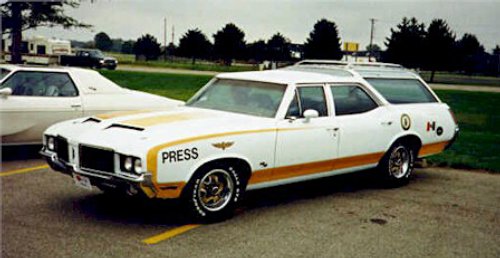
W-45 is for the H/O option which replaces the paint code on the body tag.
W-30 was optional for the 72 H/O. If yours has the other 455, there should be a U in the VIN instead of the X.
All H/O paint striping resembles the Indy Pace car color scheme. All were painted Cameo White. The 72 H/O came with Rallye Suspension, dual exhausts, power front disc brakes and a 3:23:1 axle ratio. All were equipped with Turbo-Hydro Matic, shifted through a Hurst Dual Gate Unit. Hurst made a few modifications to the standard production Oldsmobile 455, but the Oldsmobile W-30 high performance V-8 could be specified by the buyer. The W-30 cars came with a 3:42:1 rear axle. anti-spin differential, and the W-25 OAI fiberglass hood.
H/O Vista Cruiser wagons were built for and used at the Indy 500.
The '72 is the lowest producion of all H/Os, with 130 convertibles, 499 hardtops, 220 of the hardtops were sunroof-equipped, for a total production run of 629.
Engine: 455 V8 300bhp@4700rpm, 370lb-ft@2800rpm.
Engine Specs: Rocket 455, 4bbl, 8.5 compression, 270hp@4400 and 370torque@3200.
Transmissions: TH-400.
1973 (Oldsmobile Cutlass 4-4-2)
GM's intermediates had new sheet metal for '73, and the H/O took advantage of the new fluid lines beautifully. For the first time, two colors were offered, Cameo white and Ebony black, both with gold accents. An even more heavily-padded vinyl roof was part of the package, which made the quarter windows smaller for a striking effect. Rather large chrome exhaust tips exited under the rear bumper, and BF Goodrich's new Radial T/A tires were used. The big 455 mill was still offered, in two states of tune, depending on whether air conditioning was ordered. Even though emissions regulations and fuel economy concerns were wreaking havoc with musclecars, the H/O still packed a respectable punch. The 455 still put out enough torque to lead a magazine tester of the time to call it "The H/O Locomotive". Still an exclusive vehicle, only 1097 were produced.
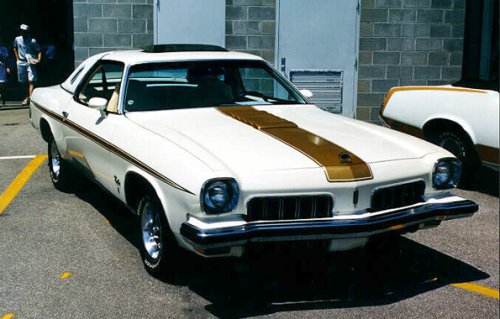
Available in Ebony Black with gold trim or Cameo White with gold trim. This was the first ever color chioce available on an H/O. Came with a broad center hood stripe, full length body stripes, and H/O emblems in middle of rear windows. 1,097 were produced only on the Cutlass S style.
Hurst/Olds package is option code W-45. This H/O was basicly a 442 with the exception of the 1/4 panel windows which were "opera" style (kinda square-ish, and very small) with a H/O decal in them. The basic 442 hood had a fiberglass "bubble" of louvers riveted on the hood which put the louvers aprox. 1" above the rest of the hood. The area around the tail lights were "blacked out" and you got the rest of the usual H/O emblems around the car. Chrome tailpipes were cool. Of special interest was the new spring loaded hood emblem "H/O".
Available options (only "neat" ones listed here): color-keyed SSIII wheels (SSII still availble). Sunroof, wide-ratio 4-speed, swivel buckets, posi axle, color-keyed dual side sport mirrors, mini console, sports console.
The Hurst/Olds came in Cameo White or Ebony Black with gold stripes and a white vinyl roof. But the fancy trim couldn't hide the loss of 50bhp as the 455 was further detuned to meet increasingly tough emission standards. Hurst/Olds models would be built in 1974, 1975, 1979, 1983, and 1984. But none of the successors could match the power of the originals.
Engine: 455 V8 250bhp@4000rpm, 370lb-ft@2100rpm.
Engine Specs: Standard was the 275hp 455. The W45 option added W-30 springs and valves (L-75 engine) and a 3.08 rear. The W46 option added a hotter cam (L77 engine), was not available with A/C, and added a 3.23 rear.
Transmissions: TH-400. and an anti-spin rear.
1974 (Indianapolis Pace Car)
Olds returned to the Brickyard again in 1974, for the third time in five years. And for the second time in three years as a Hurst/Olds. For the first time, a 350 V8 could be ordered, and was mandatory for California-bound cars. The 455 was still available, but emissions and fuel economy concerns were taking their toll. White and black were again the two color choices, and a roof band split the vinyl top in two at the B pillar to simulate the targa top on the actual pace car. Production was up some, with 1800 being produced. But, in a unique one-time deviation, there were also approximately 100 H/O conversions done on 1974 Delta 88 convertibles. They were all basically stock cars with white paint and H/O trim, but they are a striking vehicle and quite rare today. In addition, Speedway owner Tony Hulman requested a specially modified Cutlass Salon 4 door sedan for his own personal use, and it was built by Oldsmobile, but appeared at the track with H/O graphics applied. 1974 was indeed an unusual year for H/O watchers. Total production: 1800
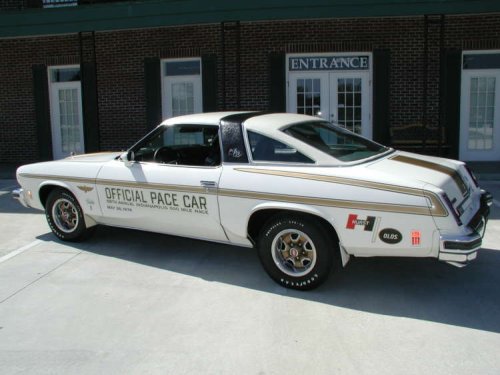
Once again Hurst teamed up with oldsmobile in 1974 to produce the limited production Hurst/Olds, which was the Indianapolis Pace Car that year as well. 1800 H/O's were produced that year and only 380, designated the W-30 package, came with the 455 engine, of which one is mine. The 350 engine car was designated the Y-77 package and was the only one available for sale in California. The 350 version retained the 'Cutlass' script on the front fenders, where as the 455 version displayed the W-30 decal in it's place.
The car could be ordered in Cameo White paint or Ebony Black paint with either a white interior or a black interior. You also could choose a white vinyl top with contrasting black roll bar vinyl insert or have it the opposite with a black top and white contrasting. As far as my knowledge, only the 455 W-30 package cars came with the Hurst Dual/Gate shifter.
A number of the cars were on duty at the Indy 500 track, but with the Indy 500 wanting a convertible, a number of white Delta 88 convertibles were striped and lettered like the pace car and used for track duties. Also, 1 four door Cutlass was made for Tony Hulman Sr.
Indy Decals were available to all H/O owners. As I recall, aside from the engines, both versions were quite similar if not identical.
A total of 1995 were built, breaking down as follows:
1800 Regular Hurst/Olds: 2 Actual Indy Pace Cars Convertibles, 100 Indy Pace Car Replica Convertibles, 1 Special built Cutlass Salon Sedan, 92 H/O 88 Convertible
Engine Specs:
W-30 option was the Rocket 455 (and TH-400 trans), while the W-25 option was the Rocket 350 (and the TH-350 trans). While the cars with the 455 carried the familiar "W-30" decals, those with the 350 had a "W-25" decal.
Transmissions: TH-400 (with option W-30), or TH-350 (with option W-25).
1975
T-tops were the coming thing in the mid-70s and the H/O's Hurst Hatches marked one of the first uses of T-tops on a production car. Convertible A-bodies disappeared in '73, and the T-tops were the next best thing. White and black again were offered, but for the first time, vinyl roofs could be mixed or matched, depending on the customer's preference. A white roof could be ordered on a black car, and vice versa. Both 350 and 455 cubic inch V8s were offered, and in a sign of the times, more 350s were sold than 455s. Suspension and tire technology were improving, and the '75 H/O provided a good balance between ride and handling. This year also marked another increase in sales, with 2535 units produced. 1293 White/1242 Black
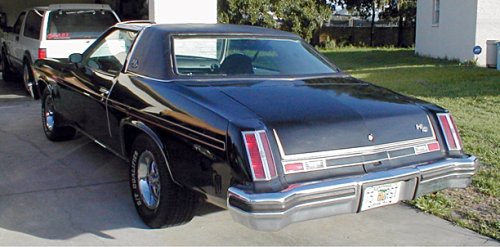
The 75 H/O was available in the Cutlass Supreme Coupe in either white or black with gold accent striping. Interior colors are either white or black.
Hurst/Hatch T-Tops introduced and installed in all cars. This was the last year for the 455. Exterior colors were Cameo White or Ebony Black.
Engine Specs: Rocket 455 or Rocket 350. W-30 option was the Rocket 455 (and TH-400 trans), while the W-25 option was the Rocket 350 (and the TH-350 trans). While the cars with the 455 carried the familiar "W-30" decals, those with the 350 had a "W-25" decal.
1979
After a 3 year hiatus, the H/O returned in '79 on GM's newly downsized Cutlass body. The first H/O to be built entirely by Oldsmobile Division, it was also the first H/O that did not offer a 455 engine. But it was the only GM A-body to offer a 350 V8 in '79. White and black again were the color choices, but with a wider choice of interior trims than ever before. Gold paint covered the hood, most of the top, and the very rear of the trunk. The aluminum wheels were also painted gold, along with the grille. At 54 for the conversion, it was the most expensive H/O ever, but even so, sales held steady at 2499 units.
They only made 2,499 of them in 1979. 1165 white and gold and 1334 black and gold 537 with the Hurst Hatch T-tops. Base Body: Cutlass Calais
Actually built at an Oldsmobile plant instead of Hurst Performance. These are the only year of Hurst/Olds production which were produced completely in an Oldsmobile plant and not trimmed out in a Hurst or Cars and Concepts facility. Last year for Hurst Dual/Gate Shifter.
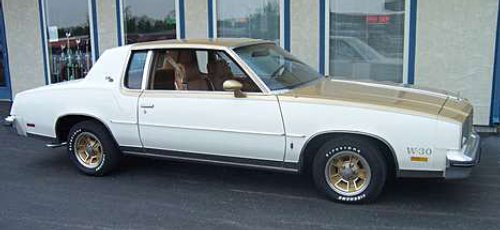
A total of 2499 were built. 1165 in Cameo White, 1334 in Ebony Black, and 537 came w/Hurst Hatch T-Tops. Hurst/Olds in '79 were the only Cutlass with W-30 stickers in '79. The Hurst wheels were actually an Oldsmobile factory aluminum wheel that was available on the 1978 Cutlass'. The Hursts wheels were painted gold, and were not on any other Cutlass in '79 but the H/O.
To order a '79 H/O, you had to start by ordering a Cutlass Calais. Therefore all of the standard Calais features for that year, such as reclining bucket seats and Rallye Pack instrumentation, were standard on the H/O. In addition to the 350/350 engine and transmission combination, the Hurst/Olds package included aluminum wheels and the two-tone sport paint which were Cutlass options. Only on the Hurst/Olds however, were the wheels painted gold and was the second paint color gold. No other Oldsmobile in 1979 used that gold paint, but I believe that it was available on some Pontiacs.
Also, only on the H/O were the hood ornament and rocket emblem on the header panel in black. H/O emblems were put only on H/O cars. On a "normal" Calais, these were both red. Finally, the H/O package included the Dual Gate shifter, which was installed in the standard Calais console. I believe that all of these cars had a 2.73 to 1 final drive ratio, regardless of if the axle was limited slip or not.
Sport steering wheel, bucket seats, 442 suspension, and guage package was standard on H/O because it is a Cutlass Calais which had these standard.
Engine Specs: Rocket 350. All had the Olds 350 V-8 and TH-350 transmission which were standard in the Delta 88 that year. These were the only Cutlass-bodied cars built with the Olds 350 in 1979. H/O did not come with true dual exhaust.
Transmissions: TH-350 with Hurst Shifter. The Hurst shifter and console is exclusive only to the '79 Hurst/Olds and no other Cutlass in '79.
1983
Once again, 3 years passed before the introduction of the next H/O. For it's 15th Anniversary Edition, the '83 H/O came only in black with silver rocker panels. Chrome 15" wheels fitted Goodyear GT tires, and a power bulge hood and rear spoiler gave the car a purposeful look. A modified version of Oldsmobile's 307 CID V8 was installed, along with 3.73 gears and Hurst's radical Lightning Rods shifter. Dual exhausts with rumbling mufflers meant there was no mistaking the H/O for a garden variety Cutlass. A new style "Hurst/Olds" emblem was introduced, and red and silver stripes separated the black and silver paint. Demand for the car was very strong. Originally, 2500 units were scheduled to be produced, but Olds had to up that number to 3000(3001) because of high demand.
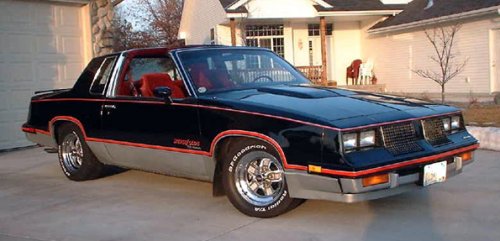
15th Anniversary model, Lightning Rod Shifter introduced. 3000 or 3001 were built.
Engine Specs: Rocket 307
1984
That may have been a factor in bringing the H/O back for '84. The paint scheme was reversed, with silver being the main body color, and black on the rocker panels. In every other respect, the '84 was identical to the '83. Total production: 2500
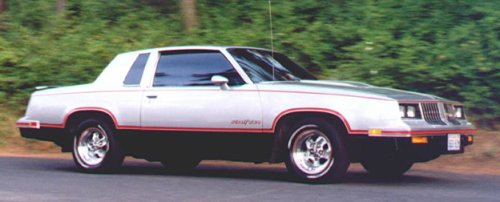
Engine Specs: Rocket 307.
Color available was black with silver. Last Hurst/Olds to be produced. Lightening rod shifters.
1988
The Hurst/Olds story took an unusual twist in '88. To commemorate the 20th anniversary of the Hurst/Olds, four 1988 H/Os were built on the last rear wheel drive Cutlass platform. The four actual H/Os were built by Doc Watson, and each was unique, to suit the personality of it's owner. Then, the aero kits that were used in the conversion were made available to the general public. These kits consisted of fiberglass ground effects packages that could be installed on any '81 - '88 Cutlass. However, only the kits that were installed on 1988 models were permitted to be badged as a 20th anniversary Hurst/Olds. Kits installed on prior year vehicles are called Hurst/Aero cars. The number of kits produced is not known, but is thought to be low enough to make it one of the rarest of all the H/Os.
The 1988 H/O which began as a concept car by Jack "Doc" Watson to the Olds factory ended up as being a "kit" car. Individuals would purchase a "kit", find a 1988 rear wheel drive Cutlass Classic car, and when you combined the two, you would have a 1988 Hurst/Olds. If the kit were put on a 1981 thru 1987 RWD Cutlass, then it would be correctly called a Hurst Aero Commerative car and NOT a 1988 H/O. With the kit was a one year membership to the Hurst Olds Club.
Originally the kit was available in the Spring of 1988 from a company called Action Products located in Tempe AZ. This company had plastics' capability through its line of mini cars, and the owner was a friend of Joe Hrudka who owned Mr. Gasket and Hurst at that time. After an initial run, Doc Watson took the molds to produce the kit, and moved everything to Michigan. It was then marketed under another company called Hurst Special Vehicles which Doc owned, and had hoped to market at that time all the items that make all years of Hurst Olds special. Best laid plans etc. The 2 kits used different plastic (revel vs ABS), and both are difficult to fit for the amateur. Once your done, and take your time, you will be rewarded with one sharp and different car.
Doc personally made four to five cars for different people, and each is different.
All H/O's were built in Lansing Michigan.
There were 10 years that H/Os were built out of 21, from 1968 thru 1988. During those 9 production runs, less than 16,000 total cars were built. Compare that to 30,000 442s built in a single model year, and you will see that the Hurst/Olds is a rare car indeed. Their unique history and combination of luxury and performance make them a topic of conversation wherever they go. For better or for worse, it is not likely that we will see a new Hurst/Olds ever again.
Lightning Rod Shifters
These are a type of shifter made by Hurst. They're standard in the '83-'84 Hurst/Olds.
Basically, they're kind of a "His-n-hers" shifter. There are three shift rods in the center console. The left one goes P R N OD D and works like a normal gearshift with the exception of no L(ow). If you shift it all the way down into D, then the car is limited to third gear or lower.
When in D, you can shift the middle lever toward you to now limit the car to 2nd gear. When it's down you can pull the right lever to limit to first. When accelerating you can start with all the shifters toward you, then throw the right, center, then left one forward while accelerating. Kind of fun, but in reality they're not much more than a gimmick, since the tranny is set to shift at about 5200rpm on WOT.
The Lightning Rods shifters might still be available from Hurst, or they might have been discontinued by the Mr. Gasket Company. Part number 385-0006 is the floor mounted model. And #385-0009 is designed to fit C*maro, F*rebird factory consoles. I would imagine one or the other of these could be adapted for your application.
History from:
http://jeffmeister.com/1969hurst/
http://www.hurstolds.com/
|